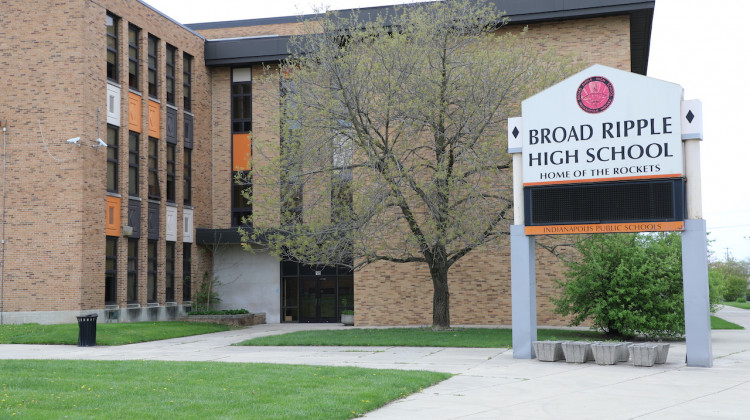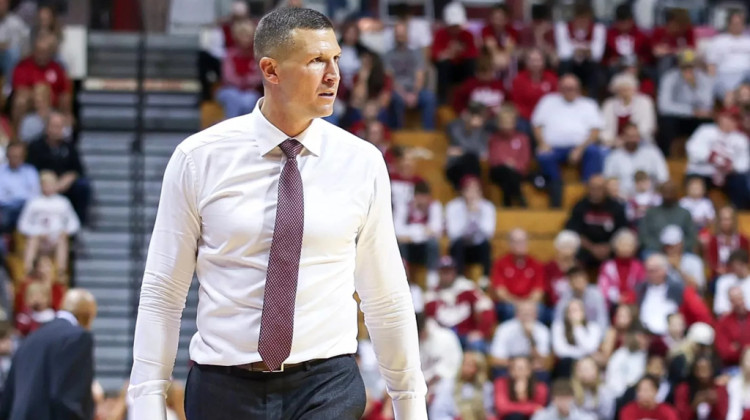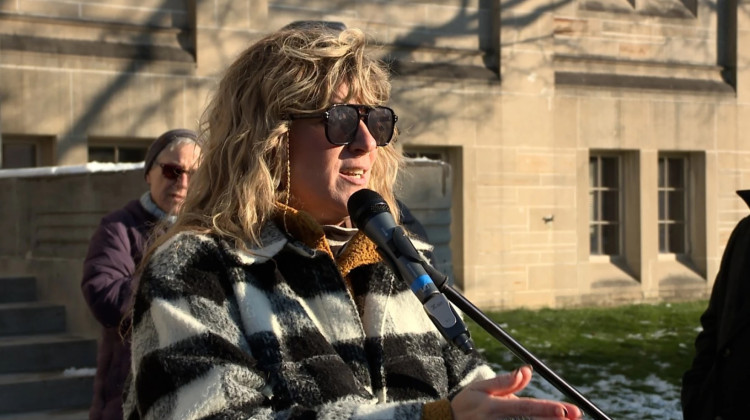
Broad Ripple High School closed in 2018. Now, the expansive IPS proposal includes a new middle school opening at the building and Purdue Polytechnic North charter school would permanently remain in the facility.
Eric Weddle/WFYIThe leader of Indianapolis Public Schools proposed a transformative plan Tuesday night to drastically reshape and rebuild the district in a defense against the myriad challenges compounded against it — from lagging student achievement and declining enrollment to unstable finances and aging facilities.
Superintendent Aleesia Johnson framed the bold plan as a “commitment that’s a century in coming” as she pledged to provide excellent academics, extracurriculars, buildings and supports to every student no matter their address or school they attend. It would also help the district budget as it teeters toward a fiscal cliff in 2026.
Johnson teed up the plan in the annual state of the district speech at Arlington Middle School.
“We have an incredible diversity of academic program options in our district — options that provide our students with great experiences,” Johnson said. “But today, they’re not available at many of our schools — especially traditional neighborhood schools. The hard truth is that our reality has been divided between choice schools, often with more challenging classes, and neighborhood schools, which haven’t always had the same offerings.”
The proposal known as “Rebuilding Stronger” — released online and set for a vote in late fall — would reshape education and life in the city. If approved by the district’s elected board, nearly all facets of IPS, outside of the current high schools, would face dramatic change by 2024-2025. The proposal does not impact most of the charter schools who partner with IPS. The nonprofits who mange these schools could decide to follow the district's lead in grade configurations.
The proposal includes:
- Closing seven elementary school buildings next summer, including three on on the city’s northeast side.
- Reconfiguring grades at nearly three dozen schools to offer preschool or kindergarten up to fifth grade, and end the K-8 school design for district-run schools.
- Establish 6-8 grade middle schools to offer International Baccalaureate, STEM, arts or other programs, including two new schools opening at buildings formerly home to the closed Broad Ripple and Thomas Carr Howe high schools.
- Construct two new elementary school buildings and improve 14 school facilities.
- Add one Montessori and two Center For Inquiry programs at current neighborhood schools, in addition to expanding seats for these and other programs at existing schools.
- Purdue Polytechnic North charter school would permanently remain in Broad Ripple High School building.
And that’s just part of the proposal that also suggests changes to preschool and special education, and the creation of a community resource center at Arlington Middle School.
District officials did not provide answers to questions about the cost of the plan or how it would be funded.
Johnson said after a year of outreach on how to improve the district, nearly 2,000 people attended dozens of virtual and in-person meetings, and more completed district surveys.
“It’s an incredible level of participation, which has helped us paint a complete picture of what this community values,” she said.
The proposal released Tuesday night is on the district website and offers details on how students and staff at individual schools will be impacted. Here is an overview:
School closures
The capacity at IPS-owned buildings is around 46,600 students, but only 28,100 students are enrolled for a 60 percent utilization rate. Johnson said more than four out of 10 students attend schools with an an enrollment low enough to increase overall expenses. The plan recommends the closure and consolidation of seven schools after the current school year due to poor conditions and low enrollment:
- George Buck School 94; Floro Torrence School 83; Raymond Brandes School 65; and Francis Bellamy Pre-School Center and Step Ahead Program will close.
- Francis Parker School 56 would close and merge with James Russell Lowell School 51. School 51 becomes a Montessori program.
- Paul Miller School 114 would close and merge with Frederick Douglass School 19. School 19 would no longer be operated as an innovation school.
- Center for Inquiry School 2 would close and merge with Washington Irving School 14 to become a CFI school.
"This is not a recommendation I make lightly,” Johnson said. “Every one of our schools is a neighborhood institution, with traditions and memories attached. I know this will cause disruption, and as your superintendent, I own that.”
School grade reconfiguration
Schools are currently configured as a mix of K-6, K-8 and 7-8 grades, with some offering preschool too. The proposed reconfiguration would confirm all elementary schools up to fifth grade and provide more resources.
Students face a vastly different experience depending on where they live or which school they attend. Foreign language, band and Algebra 1 for eighth graders are programs available at some schools, but not all.
"Those limitations have fallen especially hard on kids of color in our district, who attend neighborhood schools in higher numbers,” Johnson said. “Far too many have been denied the exact kind of offerings that make kids excited about school."
All K-5 schools would offer arts, music, physical education, computer science, a daily phonics curriculum from grades K-3 and more.
Middle schools
The proposal would create 6-8 grade schools at Northwest and Longfellow – each with International Baccalaureate curriculum. Arlington would be a STEM program. Harshman would offer dual Spanish-English language and high-ability programs.
Two K-8 schools would change to middle schools. William Penn as a STEM-focused program with the middle grades of Cold Spring School merged, and Edison School of the Arts would become a middle offering.
All middle schools, for students in grades 6-8, would have the option to learn an instrument, play a sport, access to pre-Algebra in seventh grade and Algebra 1 in eighth grade, a foreign language and more.
“We are not taking anything away,” said Warren Morgan, IPS chief academics officer, about opportunities established at schools. “But what we are saying this is the minimum we are doing across the board.”
Program duplication and expansion
The proposal would duplicate academically successful school models that already exist in the district.
Center for Inquiry is a curriculum based on "inquiry-based learning" and the schools are International Baccalaureate World Schools. The proposal would add two additional sites of the choice model at Carl Wilde School 79 and George Julian School 57.
A new Montessori school would be set up at Eleanor Skillen 34 for the 2024-25 school year.
James Whitcomb Riley Elementary School 43 would become Riley School of the Arts and be open to any student in the district. Edison School of the Arts would transition to a middle school.
“There are achievement disparities for children of color in some of these models, and we recognize that,” the proposal notes. “We commit to putting the appropriate supports and professional development in place to ensure all IPS students are performing at the highest levels.”
Enrollment zones
IPS would be divided into roughly four zones reflecting the district’s diversity by race and income, Johnson said. Families could pick any school in their zone to attend. Each zone would have similar offerings for grades K-5 and 6-8. Currently, students are automatically assigned to their neighborhood school based on its boundary, or can choose to attend most any magnet or choice school in the district no matter where they live.
End priority zone enrollment
Currently, the district enrollment lottery gives preference to families with homes located within a half-mile radius of a choice school option. This is known as the proximity priority, as families living in the boundary would be favored to win a seat in the district’s lottery enrollment for a high-demand school. The proposal would end the proximity priority.
Building upgrades
Fourteen schools would be improved, from expansions and renovations, to improved athletic fields and security upgrades. A new Francis Parker School 56 and Joyce Kilmer School 69 will be built, each would hold 650 students and be 98,0000 square-feet.
Impact on teachers, staff
Around 330 district staff will be impacted by the changes. Johnson said layoffs are not expected. The district will offer retention bonuses if the funding is approved by the state education department: $10,000 for staff members directly impacted by the changes, $12,000 for principals facing changes like school consolidation and $20,000 for principals experiencing building closure. Those retention bonuses must receive approval from the state.
What is next
Nearly a dozen meetings are scheduled through October for the public to weigh in on the plan. Meetings will also be held at individual schools for families to learn more about how the proposed changes would impact them.
Contact WFYI education editor Eric Weddle at eweddle@wfyi.org or call (317) 614-0470. Follow on Twitter: @ericweddle.
 DONATE
DONATE






 Support WFYI. We can't do it without you.
Support WFYI. We can't do it without you.